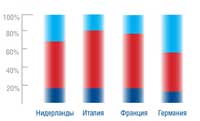Anorexia Statistics
 According to the National Institutes of Mental Health (NIMH) on anorexia statistics, the lifetime prevalence of Anorexia Nervosa in U.S. adults is 0.6%. But Anorexia is not exclusively found in America. Worldwide, the prevalence of Anorexia Nervosa is estimated to be 0.3% in young women.
According to the National Institutes of Mental Health (NIMH) on anorexia statistics, the lifetime prevalence of Anorexia Nervosa in U.S. adults is 0.6%. But Anorexia is not exclusively found in America. Worldwide, the prevalence of Anorexia Nervosa is estimated to be 0.3% in young women.
There are geographical and cultural differences in the prevalence of anorexia nervosa and anorexia statistics. Western countries have a higher overall prevalence of the disorder than Non-Western countries but the rate seems to be increasing in the East. Soon Non-Western countries will have a prevalence of Anorexia Nervosa that will match that in the West, ranging from 0.1% to 5%.
Anorexia statistics show that more females than males are affected by anorexia nervosa and thus have a higher lifetime prevalence of 0.9%. This is as compared to males whose significantly lower lifetime prevalence is 0.3%. Anorexia nervosa also disproportionately affects younger adults and adolescents. It is the third most common chronic illness in teens. Also, prevalence of aAnorexia nervosa is higher in homosexual males than in the general population. Some anorexia statistics indicate that up to 20% of gay men develop Anorexia Nervosa whereas only 10% of anorexics are heterosexual males.
Anorexia statistics find that pregnant women with active Anorexia Nervosa tend to gain less weight during pregnancy and give birth to babies with lower birth weights. Pregnant anorexics gain only 15.8 pounds on average during gestation whereas the normal pregnant woman gains around 25 pounds. Babies born to anorexics weigh in at an average of 4.9 pounds as compared to their counterparts born to normal woman who weigh on average 6 to 9 pounds. A lower birth weight is associated with health complications for the infant.
Although anorexia nervosa is a treatable condition, it is serious and potentially fatal. Statistical analysis estimates from NIMH suggest that up to 10% of those with Anorexia Nervosa my die from complications associated with the disorder. According to the Renfew Center Foundation for Eating Disorders, that estimate is low and up to 20% of anorexics will die from the condition. Their statistics indicate that the mortality rate for people with Anorexia Nervosa is twelve times higher than the death rate of all causes in women aged 15 to 24.
Sadly, NIMH anorexia statistics indicate that less than 40% of people with anorexia nervosa ever receive treatment for their condition throughout their entire lifetime. Though treatment can be very effective, relapse rates are high. Relapse rates may be improved in persons who can gain enough weight to be at least 95% of their normal predicted body weight.
 Eating Disorder Self Test. Take the EAT-26 self test to see if you might have eating disorder symptoms that might require professional evaluation. All answers are confidential.
Eating Disorder Self Test. Take the EAT-26 self test to see if you might have eating disorder symptoms that might require professional evaluation. All answers are confidential.